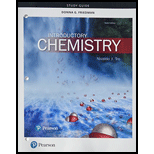
Interpretation:
The formula for the compound formed by the element potassium when it is combined with acetate, chromate, phosphate, and cyanide is to be written.
Concept introduction:
Ions that are composed of a group of atoms with an overall charge are known as polyatomic ions.
In order to write the formula for ionic compounds containing polyatomic ions, use the formula and charge of the polyatomic ions.
To write the formula for the ionic compound that contains polyatomic ions, follow the following rules:
1. Write the symbol of the metal ion followed by the polyatomic ion’s symbol, their charges can be deduced from their group numbers in the periodic table.
2. The magnitude of the charge on each ion as a subscript is to be used as the subscript for the other ion.
3. Check if the subscripts can be reduced to simpler whole numbers.
4. Check and confirm whether the sum of the charge on the cation is equal to the sum of the charges of the polyatomic ions.
Want to see the full answer?
Check out a sample textbook solution
Chapter 5 Solutions
Study Guide for Introductory Chemistry
- Determine a chemical formula from elemental analysis (i.e., from % composition).arrow_forwardA jar contains some number of jelly beans. To find out precisely how many are in the jar, you could dump them out and count them. How could you estimate their number without counting each one? (Chemists need to do just this kind of bean counting when they work with atoms and molecules. Atoms and molecules are too small to count one by one, so chemists have worked out other methods to determine the number of atoms in a sample.)arrow_forwardA 43.0 g sample of hydrated cobalt (II) sulfite is heated resulting in anhydrous cobalt (II) sulfite with a mass of 26.1 g. Write the formula of the hydrate.arrow_forward
- 1.Name the compoundarrow_forwardAnalysis of a 39.8 g sample of water revealed a mass percent for lead of 4.87%. Calculate the number of grams of lead in this sample.arrow_forwardUsing your knowledge of how properties change when a compound is formed, explain why sodium chloride (table salt) is so safe when sodium and chlorine as elements are not safe.arrow_forward
 Chemistry for Engineering StudentsChemistryISBN:9781337398909Author:Lawrence S. Brown, Tom HolmePublisher:Cengage Learning
Chemistry for Engineering StudentsChemistryISBN:9781337398909Author:Lawrence S. Brown, Tom HolmePublisher:Cengage Learning Introductory Chemistry: An Active Learning Approa...ChemistryISBN:9781305079250Author:Mark S. Cracolice, Ed PetersPublisher:Cengage LearningChemistry: Matter and ChangeChemistryISBN:9780078746376Author:Dinah Zike, Laurel Dingrando, Nicholas Hainen, Cheryl WistromPublisher:Glencoe/McGraw-Hill School Pub Co
Introductory Chemistry: An Active Learning Approa...ChemistryISBN:9781305079250Author:Mark S. Cracolice, Ed PetersPublisher:Cengage LearningChemistry: Matter and ChangeChemistryISBN:9780078746376Author:Dinah Zike, Laurel Dingrando, Nicholas Hainen, Cheryl WistromPublisher:Glencoe/McGraw-Hill School Pub Co World of Chemistry, 3rd editionChemistryISBN:9781133109655Author:Steven S. Zumdahl, Susan L. Zumdahl, Donald J. DeCostePublisher:Brooks / Cole / Cengage Learning
World of Chemistry, 3rd editionChemistryISBN:9781133109655Author:Steven S. Zumdahl, Susan L. Zumdahl, Donald J. DeCostePublisher:Brooks / Cole / Cengage Learning Chemistry: An Atoms First ApproachChemistryISBN:9781305079243Author:Steven S. Zumdahl, Susan A. ZumdahlPublisher:Cengage Learning
Chemistry: An Atoms First ApproachChemistryISBN:9781305079243Author:Steven S. Zumdahl, Susan A. ZumdahlPublisher:Cengage Learning ChemistryChemistryISBN:9781305957404Author:Steven S. Zumdahl, Susan A. Zumdahl, Donald J. DeCostePublisher:Cengage Learning
ChemistryChemistryISBN:9781305957404Author:Steven S. Zumdahl, Susan A. Zumdahl, Donald J. DeCostePublisher:Cengage Learning





